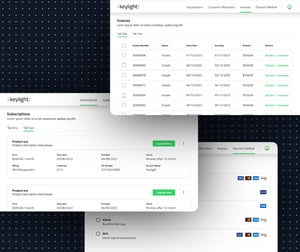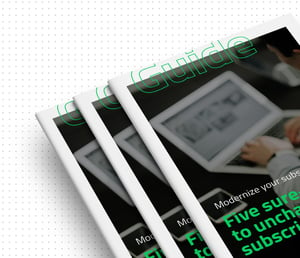Sales Operations & Technology for Subscription Businesses | Part four
 ore and more businesses are turning to subscription-based B2B models across sectors as their sustainable growth benefits become ever clearer. However, many organizations find that they are inhibited by their internal workflows, particularly where they haven't been developed with subscription growth specifically in mind.
ore and more businesses are turning to subscription-based B2B models across sectors as their sustainable growth benefits become ever clearer. However, many organizations find that they are inhibited by their internal workflows, particularly where they haven't been developed with subscription growth specifically in mind.
A critical area is the end-to-end quote-to-cash (QTC) process; a pivotal element encompassing a myriad of sales, account management, order fulfillment, and billing functions.
This article looks at how the QTC process needs to be redefined for subscription businesses and their sustainable growth.
Why an automated QTC process is essential for subscription growth
QTC incorporates a variety of financial elements, all of which need to be considered from the central ethos of an effective subscription business - customer experience. Those elements include but are not limited to quoting, contracting, invoicing, collections and renewals.
The reason QTC is so pivotal to subscription businesses is that it not only influences the process by which a customer buys from you, but it informs their sense of trust and enjoyment when it comes to engaging with your organization. QTC creates lasting impressions which will influence both customer retention and whether they recommend you to others - all directly impacting business growth.
However, the quote-to-cash process in subscription businesses focuses on finance and is mostly optimized for linear transactions rather than continuous customer relationships. The result is that many businesses find that theory and practice are misaligned. As the business matures it becomes unable to keep up with the realities of daily operations and customer expectations.
Sales teams spend a lot of time creating quotes, following internal processes to get approvals, and entering orders into different systems, instead of working closely with the customers to meet their needs. Customers become disappointed by messy or poor experiences and the workarounds become convoluted, slow, and expensive - inhibiting business growth through the inability to maintain a healthy sales pace.
To keep up with the pace of any growing subscription model it’s important that businesses start with a purposefully designed, user-centric system, and that there's a culture of continuous development and reinvention of the entire QTC approach.
How to employ the ultimate quote-to-cash approach
In their article How quote-to-cash excellence can fuel growth for B2B subscription businesses, Mckinsey writes:
"Optimizing QTC for growth requires a series of concerted design decisions and trade-offs across the end-to-end journey. At the highest level, it involves striking the right balance between standardization and customization."
These two features of QTC are equally important but bring very different benefits to the process. The key is deciding which are the most important quote-to-cash decisions and which are best served through simplicity or flexibility.
Simplify QTC with standardized automation
We have written a lot about the importance of automation in various areas of subscription businesses. Automation is one of the great merits of the digital world, enabling businesses to optimize the customer experience, increase conversion rates and maximize the enterprise's resources. In the QTC process, automation is an essential pillar, standardizing the majority of processes for a simpler, more robust core.
Benefits include:
- Less friction in the order process
- Reduced billing complexity
- Improved customer experience
- More expedient transactions
- Together this enables more time for your team to support more customers
The process towards implementing automation for QTC includes:
- Creating tailored customer journeys for multiple customer segments with self-service flows.
- Having an elastic product catalog with predefined product bundles to enable a smooth quoting process for sales representatives.
- Providing guided-selling flows to support complex deal configuration
- Implementing tailored conversion paths in the customer portal to maximize customer lifetime value.
- Consistent and automated billing and payment experiences to limit manual errors and increase speed
However, the downside to automation is that it can become rigid and impersonal.
Customizable automation in the QTC process
The antidote to automation's rigidity and lack of personalization is customization. Personalization is the essence of modern businesses. It's crucial for customer satisfaction that people find the right solution and experience for them, and that it's easy and simple for all users - both customers and sales team members.
For businesses, the challenge is in understanding where flexibility is important to their customers. For example, the timeliness of the billing and payment options.
Customization enables you to meet the values and expectations of the individual depending on broad as well as narrow characteristics, creating an experience that suits them to maximize customer retention and satisfaction.
Benefits include:
- Improved customer experience
- Improved customer retention
- Improved customer satisfaction and less time spent troubleshooting
- Recommending you to other customers
- These come together for sustainable business growth
The process towards implementing customization for QTC includes:
- Use rules and conditions to display the right products or execute internal workflows such as approval processes or payment options for specific customer segments.
- Recognizing that customers are moving towards value-based, usage-based billing and creating systems that support customizable billing cycles that can actively meter usage and rapidly explain the use to the customer.
- Enabling multiple payment methods that suit different customers, particularly relating to local markets.
Designing for sustainable growth
Billing is not usually considered to be an emotional part of business, but the QTC experience and financials are essential to making customers feel safe, happy, and secure in doing business with you. If checkout pages feel wrong, individuals can be put off, and if a process takes longer than it should customers drop out at the last hurdle.
Designing a customer and user-centric QTC process can be intricate and detailed, but starting in the right place means creating the right foundations for the growth and sustainability of your subscription business. Without considering each of the design detail upfront, it can become costly down the line both in terms of corrective measures and missed opportunities. Those who recognize this have consistently outperformed their competitors in the market in terms of adding new accounts, growing existing accounts, and reducing customer churn. The key to making it work for the business and the customer balances and having a modern subscription platform in place.

Replace traditional engines with
an event-driven subscription system
Start now with >keylight/




